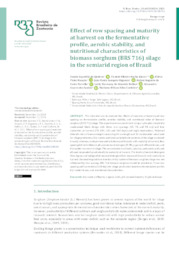Effect of row spacing and maturity at harvest on the fermentative profile, aerobic stability, and nutritional characteristics of biomass sorghum (BRS 716) silage in the semiarid region of Brazil.
Effect of row spacing and maturity at harvest on the fermentative profile, aerobic stability, and nutritional characteristics of biomass sorghum (BRS 716) silage in the semiarid region of Brazil.
Autoria: QUEIROZ, F. E. de; ROCHA JUNIOR, V. R.; MONÇÃO, F. P.; RIGUEIRA, J. P. S.; PARRELLA, R. A. da C.; RUFINO, L. D. de A.; SANTOS, A. S. dos; CORDEIRO, M. W. S.
Resumo: The objective was to evaluate the effects of maturity at harvest and row spacing on fermentative profile, aerobic stability, and nutritional value of biomass sorghum (BRS 716) silage. The experiment was conducted using a split-plot completely randomized block design with three row spacings (45, 70, and 90 cm) and four maturities at harvest (70, 100, 130, and 160 days) and eight replications. Polyvinyl chloride silos of known weight measuring 50 cm length and 10 cm diameter were used for silage production. Dry matter and total carbohydrate contents of the silage increased linearly, whereas crude protein and ash decreased linearly with maturity at harvest. Row spacing did not influence pH, ammoniacal nitrogen (N-NH3 ), gas and effluent losses, and dry matter recovery of silage. The concentrations of malic, succinic, and acetic acids and ethanol responded quadratically to maturity at harvest. The levels of neutral detergent fiber, lignin, and indigestible neutral detergent fiber increased linearly with maturity at harvest. Ruminal degradation kinetics of dry matter of biomass sorghum silage was not influenced by row spacing. BRS 716 biomass sorghum should be planted at 70-cm row spacing and harvested at 160 days for silage production based on fermentative profile, dry matter losses, and nutritional characteristics.
Ano de publicação: 2021
Tipo de publicação: Artigo de periódico
Unidade: Embrapa Milho e Sorgo
Palavras-chave: Cinética ruminal, Colheita, Espaçamento, Maturidade, Matéria Seca, Sorghum Bicolor, Sorgo, Ácido Orgânico
Observações
1 - Por padrão são exibidas publicações dos últimos 20 anos. Para encontrar publicações mais antigas, configure o filtro ano de publicação, colocando o ano a partir do qual você deseja encontrar publicações. O filtro está na coluna da esquerda na busca acima.
2 - Para ler algumas publicações da Embrapa (apenas as que estão em formato ePub), é necessário ter, no celular ou computador, um desses softwares gratuitos. Sistemas Android: Google Play Livros; IOS: iBooks; Windows e Linux: software Calibre.
Acesse outras publicações
Acesse a Base de Dados da Pesquisa Agropecuária (BDPA) para consultar o acervo completo das bibliotecas da Embrapa.

